A $15.99, travel-ready fix that restores most mechanical watches—fast and simple, with a few limits.
If your mechanical watch suddenly runs fast, slow, or skips time, magnetization is a surprisingly common culprit — everyday items like phones, speakers, or bag clasps can throw off a delicate balance spring and wreck accuracy. Getting a professional degaussing can be effective but usually means cost, time, and a trip to a watchmaker.
The Watch Demagnetizer is a compact, one-step tool (includes compass, cleaning cloth, and instructions) that lets you quickly demagnetize most mechanical watches at home or while traveling. It’s an affordable, intuitive first-line fix that often restores accurate timekeeping, though deeply magnetized movements or electronic issues may still need professional service.
TICFROG Watch Demagnetizer Degaussing Kit with Compass & Cloth
A compact and effective demagnetizer that returns most mechanical watches to accurate timekeeping quickly and affordably. It’s an excellent first-line tool for owners who want a practical fix without a specialist visit, though severe cases may still need professional service.
Demagnetize Your Watch Effectively: A Simple Chrono24 Guide
Overview
The TICFROG Watch Demagnetizer is a small, user-friendly tool designed to remove unwanted magnetism from mechanical wristwatches. Magnetization is a common but often overlooked cause of sudden timing errors in watches — plates sticking, hairsprings clinging, or timekeeping running fast or slow. This demagnetizer offers a straightforward, low-cost way to restore a watch’s regulation without immediate professional servicing.
What’s in the box
Key Features and How They Work
Quick Compatibility Guide
| Watch Type | Suitable? | Notes |
|---|---|---|
| Mechanical (manual / automatic) | Yes | Primary target — effective for typical magnetization of balance springs and nearby small components. |
| Quartz (battery-powered) | Limited | Quartz movements are generally less affected, but internal electronics can be sensitive — caution recommended. |
| High-end modern alloys (anti-magnetic alloys) | Not necessary | Many modern watches already use anti-magnetic materials; demagnetizing isn’t usually required. |
Step-by-Step Usage (Typical Procedure)
Safety and Best Practices
Real-World Performance and Typical Results
Owners report substantial corrections from severe gains (tens or hundreds of seconds per day) to near-original accuracy after a single treatment. For minor magnetization issues, a quick pass often returns a watch to within a few seconds per day. However, if timekeeping remains erratic after treatment, the underlying cause may be mechanical wear or a service-level issue that requires a watchmaker.
Maintenance and Care
Troubleshooting Quick Chart
| Symptom | Likely Cause | Suggested Action |
|---|---|---|
| No change after degaussing | Extremely strong magnetization or nonmagnetic cause of timing error | Repeat procedure; if no improvement, consult a watchmaker. |
| Watch runs slower after treatment | Overcompensation or unrelated mechanical issue | Monitor for 48 hours; if persistent, seek professional diagnosis. |
| Compass shows no deviation but watch still inaccurate | Non-magnetic mechanical problem (wear, oil, misalignment) | Consider a full service. |
Who Should Buy This
Final Notes
While not a substitute for professional servicing, this demagnetizer is a cost-effective, low-friction tool that addresses one of the most common causes of sudden timing errors in mechanical watches. It’s especially valuable as a preventative item in a watch-care kit or as a diagnostic first step to rule magnetization in or out before committing to more expensive repairs.

FAQ
A simple way is to use the included compass: hold the compass near the watch and watch the needle. If it moves significantly when the watch is brought close, the watch likely has magnetic influence.
Other common signs:
If you suspect magnetization, compare the watch to a known accurate clock over 24 hours or use a timing machine at a service shop for a definitive measurement.
When used according to instructions, the unit demagnetizes components without mechanical contact and should not damage the case or finish.
Precautions to reduce risk:
If you have a high-value or vintage watch, consider professional service if you are uncertain.
Caution is advised.
Before treating any electronic device, consult the manufacturer or test with a small trial and inspect operation afterward. Avoid treating devices that are under warranty without checking terms.
Often a single correct pass is sufficient for typical magnetization.
If needed:
Verify results by observing timekeeping over several hours or using a timing machine for the most reliable assessment.
Yes for quick diagnostics and simple fixes. It is compact and convenient for on-the-spot checks and minor demagnetization tasks.
Limitations to consider:
For many technicians and hobbyists, this tool provides a practical, portable option.
Keep watches away from common magnetic sources to reduce re-magnetization risk.
If magnetization is a recurring problem, consider an anti-magnetic watch or having components (like the hairspring) checked by a watchmaker.
Follow the included instructions. A typical safe procedure is:
Do not leave the watch on the unit for long continuous periods. If unsure, follow the manufacturer sheet or consult a technician.
Demagnetization removes residual magnetism from components, and the effect can be long-lasting.
Check your watch after exposure to magnetic sources and re-treat if necessary. If magnetization recurs frequently, have the movement inspected for underlying issues.


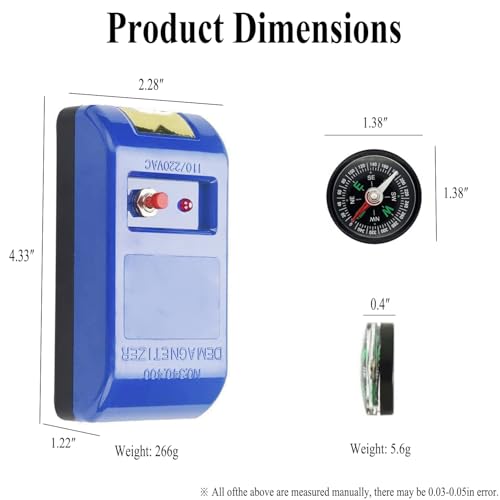
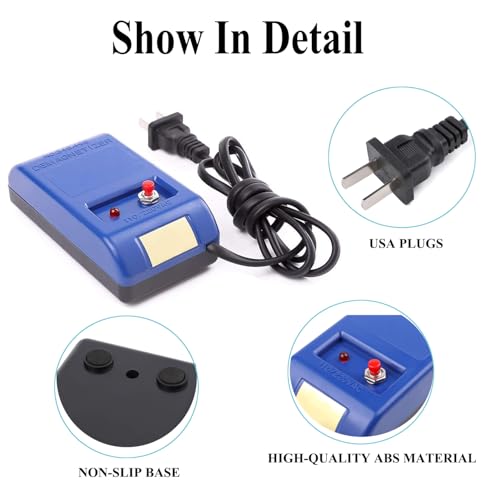

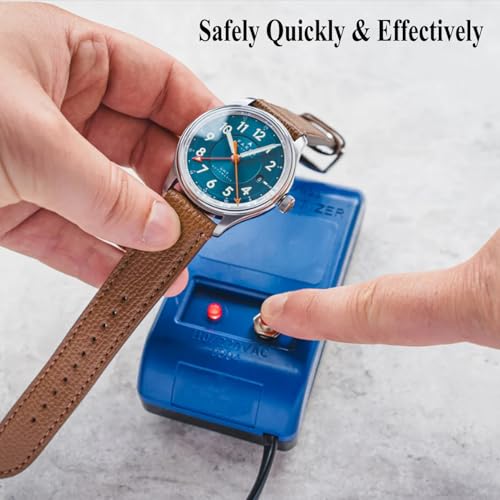
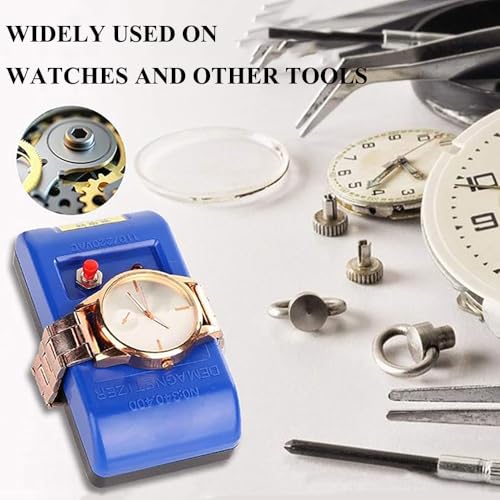
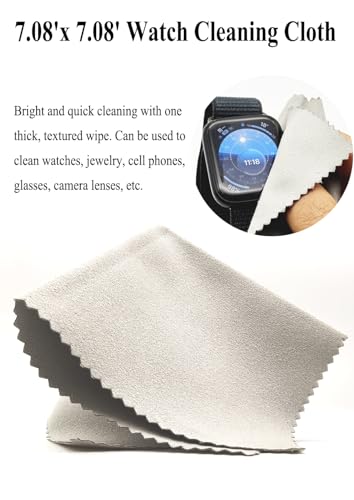
Bought it as a ‘fix it yourself’ starter kit. The instructions were okay but could use photos. Video tutorial would make this 10/10.
Might buy another as a spare to keep in my toolbox.
Awesome, I’ll check YouTube. Thanks!
There are a few YouTube demos that helped me. Search the product name + ‘demo’ and you’ll find good walk-throughs.
Thanks, Noah — we’ll look into adding video content. Visual steps definitely help for first-time users.
I used the TICFROG as recommended and it fixed the magnetized compass in the kit (fun extra) and my grandfather’s pocket watch. Pleasantly surprised.
Also the cleaning cloth is nicer than I expected — doesn’t feel like cheap plastic.
Agree on the cloth — surprising quality for the price.
Thanks for the review, Benjamin. The compass is a small but handy inclusion for checking orientation — glad it came in useful.
Yep. Small touches matter.
This is where home horology gets fun. For $16 you can perform basic diagnostics at home before committing to service costs.
If you like tinkering, buy it. If you’re nervous, have a pro do it. Simple as that.
Exactly. It’s empowering to try small fixes yourself.
Well said, Emma — it’s a great entry-level tool for enthusiasts who want to learn.
And remember: document what you do — helps if you later take it to a watchmaker.
Anyone tried demagnetizing a watch bracelet (metal links) or does it only target the movement? I worry about messing with the metal parts vs. the movement itself.
Degaussing affects magnetic fields generally, so metal bracelets can be demagnetized but they usually don’t need it. Focus on the watch head near the movement — just keep it steady.
I moved the bracelet away and focused on the case. Seems safer and more effective.
Good to know — thanks!
Saved me $80 at the local repair shop. Took about 2 minutes and my watch was back to normal. Can’t complain for $16. 😂
That’s the kind of result we love to hear — glad it worked for you!
Right? Instant watch therapy.
Same here. My shop wanted a week and a small fortune. This was instant relief.
LOL the tiny compass in the kit is somehow the cutest thing. 😄 On a serious note, the demagnetizer worked well but the enamel on my watch case is prone to scratching, so I put a soft cloth between the tool and case as a buffer.
Thanks! It felt silly at first but no scratches so far.
I was wondering about that — good hack.
Glad you liked the compass — and excellent protective technique with the cloth.
I bought this because the price was unbeatable ($15.99 on Amazon). It fixed my Hamilton’s weird time jumps, but I noticed one gear was still a bit off.
Might need a proper service afterwards if you have other issues — it’s great as a first-aid tool.
Exactly — it’s often a quick fix for magnetization. If there are mechanical issues beyond magnetism, a full service is recommended.
No problem! If yours still skips after demag, probably best to get a watchmaker to open it.
Good to know. I have a similar Hamilton — thanks for the heads up. 👍
Honestly, I was skeptical. I imagined some tiny wizard box that costs hundreds.
This little thing does the job for most cases. My only gripe: the instructions could be clearer for left-handed people (weird, I know lol).
Ha — good point about handedness. We’ll pass that feedback along for future instruction improvements.
Yeah turning it helps. Just thought I’d complain a bit in the comments section — tradition.
Left-handed instructions? 😂 I just rotated it until it felt right. But clarity always helps.
Tried the TICFROG demagnetizer last week and it actually worked on my vintage Seiko — saved me a trip to the watchmaker. Super easy to use.
Only caveat: don’t rush it, go slow and follow the instructions. 👍
I did a few passes, about 3–5 seconds each direction. Let it rest for a minute and then check the accuracy.
Nice! How many seconds did you hold it near the watch? I always panic and move too quickly.
Thanks for sharing, Sarah! Great tip about taking it slow — the slow, steady approach avoids accidental remagnetization.
Question: can I use this on quartz watches too? I read somewhere only mechanicals are affected by magnetism.
Appreciate any clarification — don’t want to ruin my battery-powered pieces.
I used it on a quartz once (by mistake) and nothing bad happened, but I wouldn’t make it a habit. Better to be cautious.
Good question. Quartz movements can be affected differently — severe magnetization can affect accuracy, but quartz watches are less prone. The TICFROG is primarily targeted at mechanical movements.
Not impressed — my watch got better but only marginally. Maybe my problem was more than just magnetization. Expected more for the hype.
Thanks for the honest feedback, Ava. The product isn’t a guaranteed fix for all timing issues; if the movement has wear or damage, a professional service is needed.
It gains about 10 minutes a day. After demag it went down to 6. Still annoying.
Do you notice the watch losing or gaining time steadily? That could indicate something else.
FYI — be careful with vintage watches with delicate cases. The demagnetizer itself is fine, but handling old crowns/links while fiddling can cause scratches.
I ended up using a soft cloth and a slower technique to avoid any marks.
Glad it’s useful! Also, keep small screws and parts away from the edge of the table — learned the hard way. 😅
Thanks — I have an heirloom and was nervous. Will do the cloth trick.
Excellent tip, Grace. Using a cloth and stable surface is always a good safety precaution for vintage pieces.